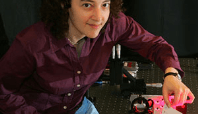Imprinting method accelerates nanodevice production
on

A simple method for stamping invisible patterns onto a special class of nanomaterials provides a new, cost-effective way to produce novel devices for applications ranging from drug delivery to solar cells. It was developed by Vanderbilt University engineers and described in the cover article of the May issue of the journal Nano Letters.
The new method works with materials called porous nanomaterials, which are riddled with tiny voids that give them unique optical, electrical, chemical and mechanical properties. For a number of years, scientists have been investigating the potential of these materials for a wide range of applications including drug delivery, chemical and biological sensors, solar cells and battery electrodes.
A major obstacle to using these materials has been the complexity and expense of the processing required to produce devices. The conventional methods for making devices from nanoporous materials are based on the process used to make semiconductor chips. This must be done in a special cleanroom and involves coating the surface with a photoresist and exposing it to ultraviolet light, or scanning the surface with an electron beam to create the desired pattern, and then performing a series of chemical treatments to etch the surface or deposit new material. The more complicated the pattern, the longer it takes to make.
About two years ago, Associate Professor Sharon M. Weiss had the idea of creating master stamps using this complex process and then using them to create devices. She and her colleagues have now developed a rapid, low-cost imprinting process that can produce a variety of nanodevices from these intriguing materials. Weiss calls the new method ‘direct imprinting of porous substrates’ (DIPS). It reduces device fabrication time to less than a minute, regardless of complexity. Her group reported that it has used master stamps more than twenty times without any signs of degradation.
The smallest pattern they have produced to date has features of only a few tens of nanometres, about the size of a single fatty acid molecule. They have also imprinted the smallest pattern yet reported on nanoporous gold, with 70-nanometre features.
Image: Neil Brake / Vanderbilt University



Discussion (0 comments)